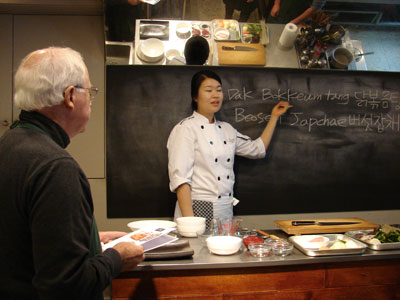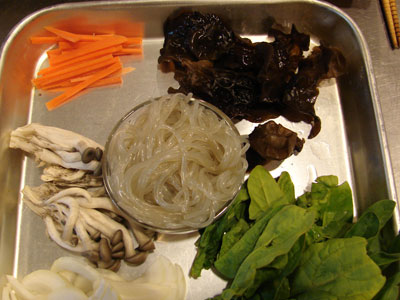What’s Cooking in… Seoul
This item appears on page 53 of the February 2014 issue.
My husband, John, and I were in Seoul, Korea, in March 2013 and enjoyed a number of meals.
In a typical Korean meal, several different dishes are placed on the table, and people use their chopsticks to serve themselves.
John and I have learned to use (but have not mastered the use of) chopsticks; most restaurants will supply Westerners with silverware. In Korea, a spoon accompanies the chopsticks and is used for rice and, if served, soup.
In Korea, unlike in other Asian countries, lifting a bowl of rice to the mouth and using chopsticks to push the rice into one’s mouth is not the usual practice.
In a place setting, chopsticks are laid to the right of the plate and pointed away from the table edge. When not in use, chopsticks should be placed on the rest that is provided, thus avoiding their dirtying the table or rolling off of it.
It is considered impolite to put chopsticks upright in a bowl of rice. It brings to mind the incense sticks placed upright in a bowl of sand at a funeral, which represents a prepared meal for the spirit of the dead. When the incense burns down, the spirit is full.
I love the saying I read years ago, though I cannot attribute it an author: “One-third of the world eats with chopsticks, one-third with their fingers and one-third with silverware — and everyone is doing it correctly.”
While in Seoul, John and I took a cooking class at O’ngo Food Communications (Jongno-gu, Nagwon-dong 55-1, 3rd floor, Seoul, Korea; phone +82 2 3446 1607) for $65 per person. The cooking school is located on the second floor of a small commercial building in the center of Seoul. The owner also organizes culinary tours of Korea.
One of the recipes we learned to make was Mushroom Japchae, a popular Korean dish that is often served on birthdays. Japchae has been popular since the 1600s, when one of the king’s subjects created the dish for a special occasion. The dish so pleased the king that the man was elevated to Secretary of the Treasury.
Literally translated, japchae means “stir-fried vegetables.” It is usually served as a side dish, but it can also be a main course.
1 shiitake mushroom, julienned
1 oz glass noodles
1 medium onion, julienned
1 medium carrot, julienned
2 dried wood ear mushrooms, soaked in hot water for 5 minutes, then drained and julienned
1 oz small-leaf spinach (can use arugula), julienned
1½ tbsp soy sauce
½ tbsp sugar
1 tsp finely chopped garlic
1 tsp finely chopped scallion
1 tsp sesame oil
½ tsp sesame seeds
Mix the soy sauce, sugar, garlic, scallions, sesame oil, sesame seeds and ginger to make the sauce. Marinate the shiitake mushroom in 1 tsp of sauce for 10 minutes. Boil the glass noodles for six minutes or according to package directions, then rinse with cold water and set aside. Sauté the onions and carrots until tender, about two minutes. Remove from pan, then in the same pan sauté the shiitake and wood ear mushrooms. Add the cooked noodles, sauce, spinach and sautéed vegetables. Sauté for 2 to 3 minutes and serve.
Other mushrooms can be substituted, and zucchini and asparagus can be added.


